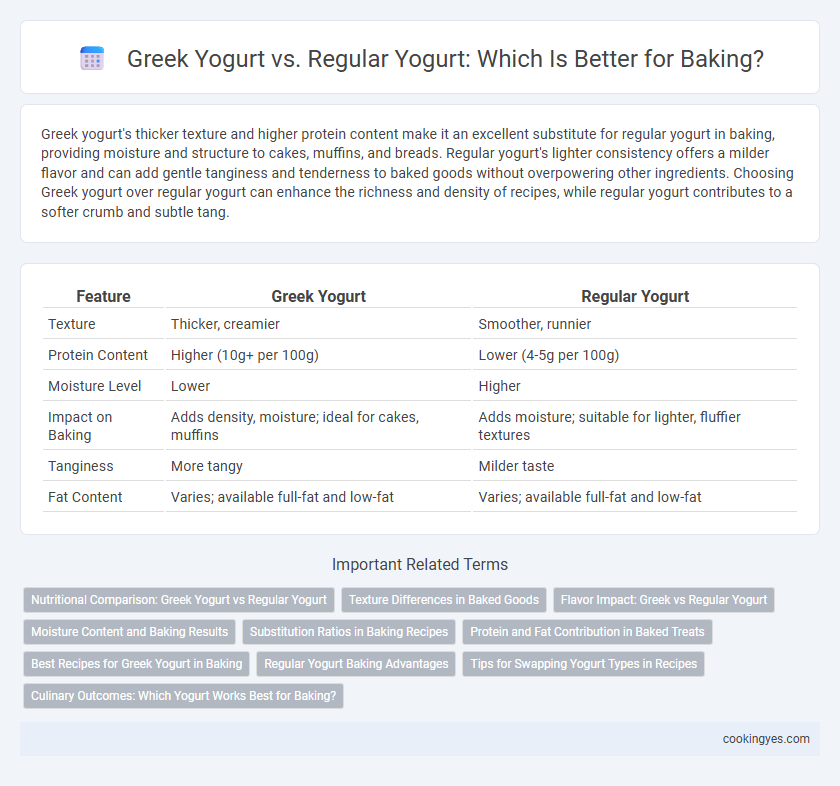Greek yogurt's thicker texture and higher protein content make it an excellent substitute for regular yogurt in baking, providing moisture and structure to cakes, muffins, and breads. Regular yogurt's lighter consistency offers a milder flavor and can add gentle tanginess and tenderness to baked goods without overpowering other ingredients. Choosing Greek yogurt over regular yogurt can enhance the richness and density of recipes, while regular yogurt contributes to a softer crumb and subtle tang.
Table of Comparison
| Feature | Greek Yogurt | Regular Yogurt |
|---|---|---|
| Texture | Thicker, creamier | Smoother, runnier |
| Protein Content | Higher (10g+ per 100g) | Lower (4-5g per 100g) |
| Moisture Level | Lower | Higher |
| Impact on Baking | Adds density, moisture; ideal for cakes, muffins | Adds moisture; suitable for lighter, fluffier textures |
| Tanginess | More tangy | Milder taste |
| Fat Content | Varies; available full-fat and low-fat | Varies; available full-fat and low-fat |
Nutritional Comparison: Greek Yogurt vs Regular Yogurt
Greek yogurt contains nearly double the protein content of regular yogurt, making it a preferred choice for baking recipes that benefit from added structure and moisture. It also has lower sugar levels and a thicker texture due to the straining process, which reduces lactose and whey content. Regular yogurt offers more calcium and a milder taste, but its higher moisture content can affect baking consistency compared to the denser Greek yogurt.
Texture Differences in Baked Goods
Greek yogurt offers a thicker, creamier texture in baked goods due to its concentrated protein content and lower moisture compared to regular yogurt, which results in denser, moister outcomes. Regular yogurt contains more whey and water, providing a lighter, softer crumb with increased tenderness in cakes and muffins. Choosing Greek yogurt enhances richness and structure, while regular yogurt yields a more delicate texture in baked treats.
Flavor Impact: Greek vs Regular Yogurt
Greek yogurt imparts a richer, tangier flavor to baked goods due to its concentrated protein and lower moisture content, enhancing texture and depth. Regular yogurt offers a milder, slightly sweeter taste with higher moisture, resulting in softer, more delicate baked items. Choosing between the two depends on desired flavor intensity and consistency in recipes.
Moisture Content and Baking Results
Greek yogurt contains less moisture than regular yogurt due to its straining process, which results in a thicker, creamier texture ideal for baking recipes requiring a denser consistency. Regular yogurt's higher moisture content makes it suitable for recipes needing more liquid, providing tenderness but potentially affecting the batter's stability. Using Greek yogurt in baking enhances richness and structure, while regular yogurt yields softer, moister baked goods but may require adjustments in other liquid ingredients to maintain desired texture.
Substitution Ratios in Baking Recipes
Greek yogurt can substitute regular yogurt in baking recipes at a 1:1 ratio, but its thicker consistency and higher protein content may require slight adjustments in liquid ingredients. Using regular yogurt in place of Greek yogurt often involves reducing the liquid in the recipe slightly due to its higher moisture level. Bakers often favor Greek yogurt for denser, creamier textures, while regular yogurt adds more moisture and tenderness in baked goods.
Protein and Fat Contribution in Baked Treats
Greek yogurt contributes higher protein content to baked treats, enhancing structure and moisture retention due to its thick texture. Regular yogurt contains more fat but less protein, which can result in softer, tender baked goods but with reduced firmness. Choosing Greek yogurt improves protein enrichment in recipes, while regular yogurt offers increased fat for richer flavor and smooth crumb.
Best Recipes for Greek Yogurt in Baking
Greek yogurt offers a thicker texture and higher protein content compared to regular yogurt, making it ideal for baking moist cakes, tender muffins, and creamy cheesecakes. Its tangy flavor enhances recipes like lemon yogurt cake or spinach and herb savory muffins, providing both richness and nutritional benefits. Substituting Greek yogurt in traditional baked goods results in a denser crumb and improved moisture retention, which is essential for successful, flavorful outcomes.
Regular Yogurt Baking Advantages
Regular yogurt offers a higher moisture content than Greek yogurt, which helps keep baked goods tender and moist, preventing dryness. Its lower protein and thicker texture make it easier to blend smoothly into batters, enhancing the overall consistency of cakes, muffins, and breads. Regular yogurt's mildly tangy flavor contributes subtle acidity that activates leavening agents like baking soda, promoting better rise and crumb structure in baked products.
Tips for Swapping Yogurt Types in Recipes
When swapping Greek yogurt for regular yogurt in baking, adjust the liquid content as Greek yogurt is thicker and contains less moisture, often requiring a slight increase in liquid ingredients to maintain batter consistency. Consider the tanginess difference; Greek yogurt is more concentrated and may alter the flavor profile, so balancing sweetness or acidity can help preserve the intended taste. Using full-fat varieties can improve texture and richness in both types, enhancing the final baked product's moisture and crumb.
Culinary Outcomes: Which Yogurt Works Best for Baking?
Greek yogurt's thicker consistency and higher protein content make it ideal for baking, providing moisture and structure without excess liquid, resulting in denser, richer textures in cakes and muffins. Regular yogurt, with its thinner texture and higher water content, can introduce more moisture but may require recipe adjustments to prevent sogginess or overly soft baked goods. For optimal culinary outcomes, Greek yogurt is preferred in recipes needing firmness and moisture retention, while regular yogurt suits lighter, more tender baked items when carefully balanced.
Greek Yogurt vs Regular Yogurt for Baking Infographic

 cookingyes.com
cookingyes.com